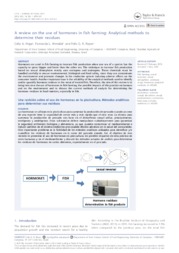A review on the use of hormones in fish farming: analytical methods to determine their residues.
A review on the use of hormones in fish farming: analytical methods to determine their residues.
Author(s): HOGA, C. A.; ALMEIDA, F. L.; REYES, F. G. R.
Summary: Hormones are used in fish farming to increase fish production when one sex of a species has the capacity to grow bigger and faster than the other sex. The technique to increase fish production based on sexual dimorphism mostly uses estrogens and androgens. These chemicals must be handled carefully to ensure environmental, biological and food safety, since they can contaminate the environment and promote changes in the endocrine system inducing adverse effects on the consumer health. Another important issue is the reliability of the analytical methods used to identify and/or quantify hormone residues in the meat of treated fish. Therefore, the aim of this review is to bring into view the use of hormones in fish farming, the possible impacts of this practice on humans and on the environment and to discuss the current methods of analysis for determining the hormone residues in food matrices, especially in fish.
Publication year: 2018
Types of publication: Journal article
Unit: Embrapa Western Amazon
Keywords: Fish farming, Piscicultura, Sexual reversion
Observation
Some of Embrapa's publications are published as ePub files. To read them, use or download one of the following free software options to your computer or mobile device. Android: Google Play Books; IOS: iBooks; Windows and Linux: Calibre.
Access other publications
Access the Agricultural Research Database (BDPA) to consult Embrapa's full library collection and records.
Visit Embrapa Bookstore to purchase books and other publications sold by Embrapa.

